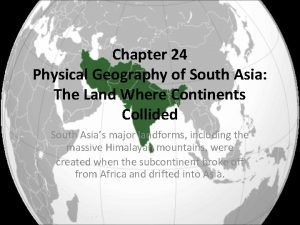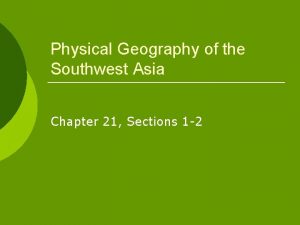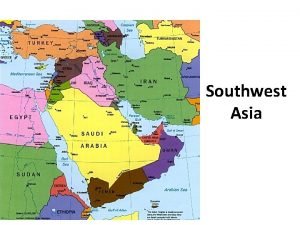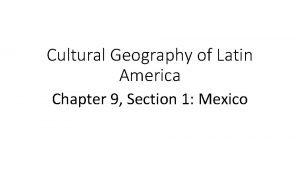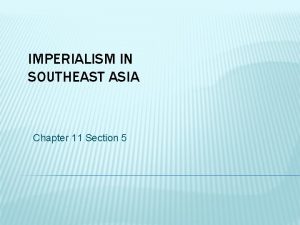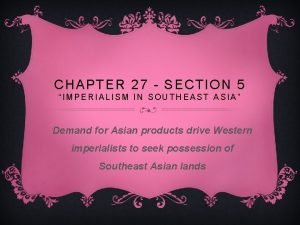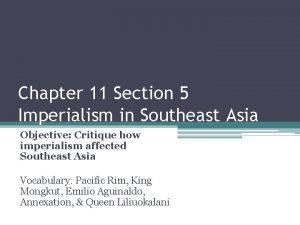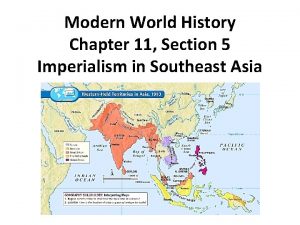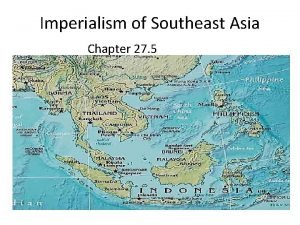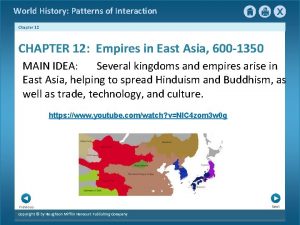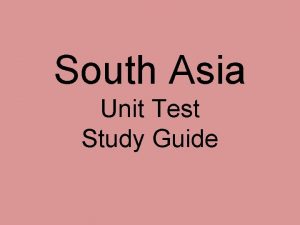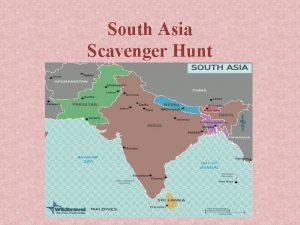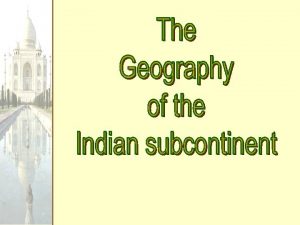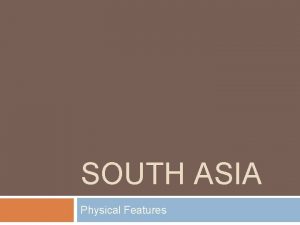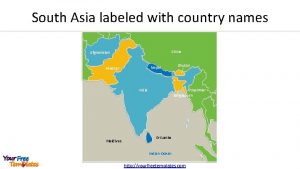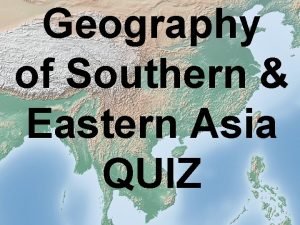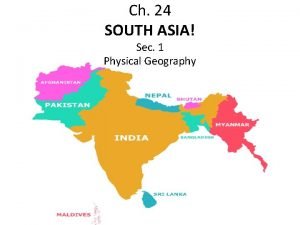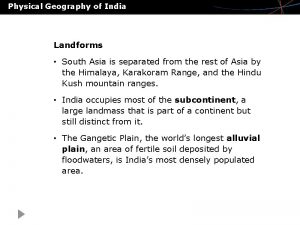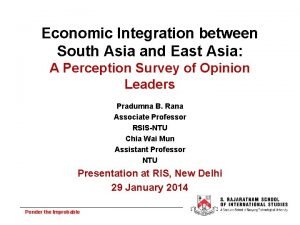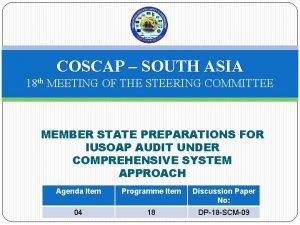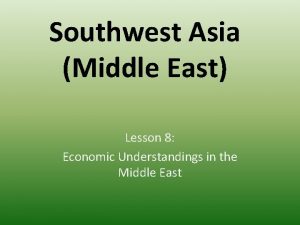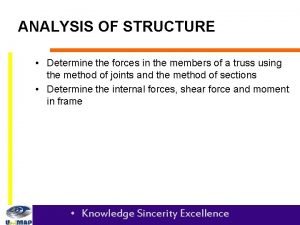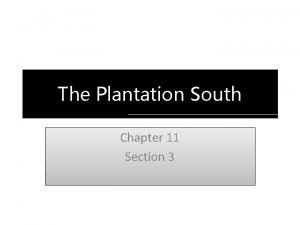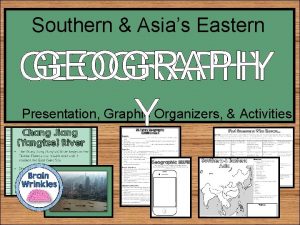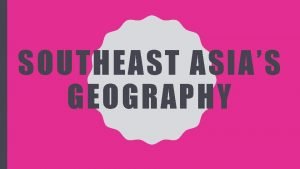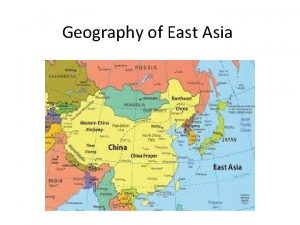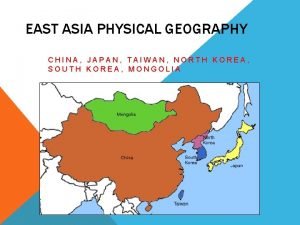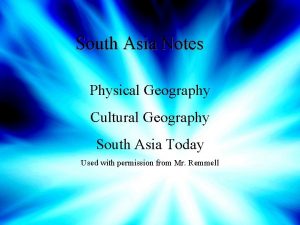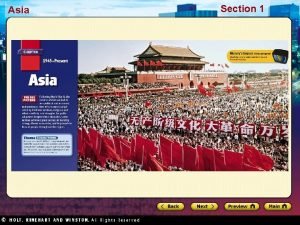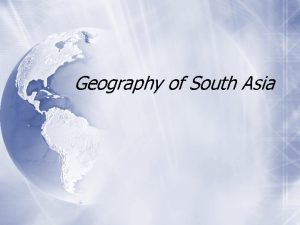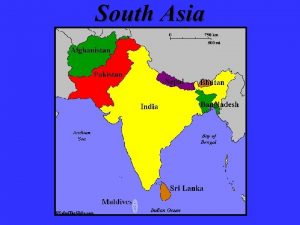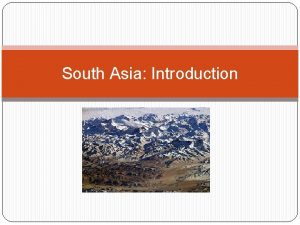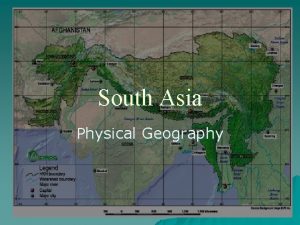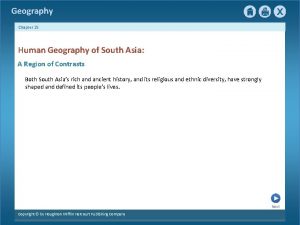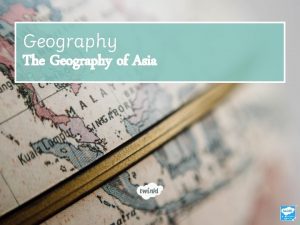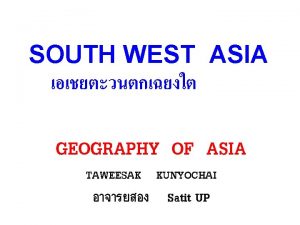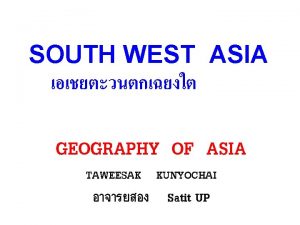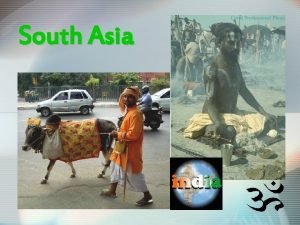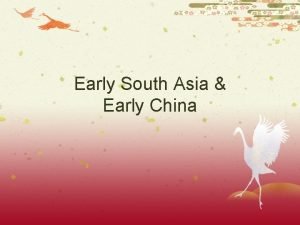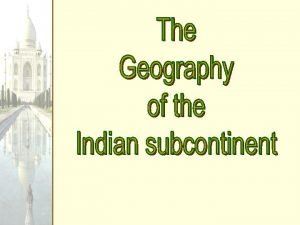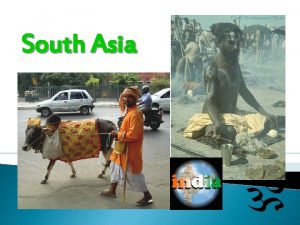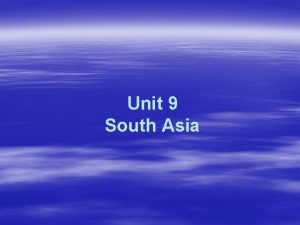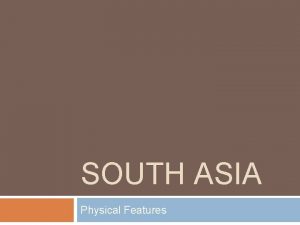CULTURAL GEOGRAPHY OF SOUTH ASIA Chapter 24 Section






































- Slides: 38

CULTURAL GEOGRAPHY OF SOUTH ASIA Chapter 24, Section 1: India

IMPORTANT VOCABULARY • Jati: a group that defines one’s occupation and social position. Ex: Hindu identification. • Megalopolis: a chain of closely linked metropolitan areas. • Dharma: moral duty. Ex: Hinduism.

VOCABULARY (CONT’D) • Reincarnation: rebirth as another living being until overcoming personal weaknesses and Earthly desires. Ex: Hinduism. • Karma: a law in which good deeds are done in accordance to one’s dharma ( social duty/responsibility). Every action has an inevitable effect, good or bad. • Mercantilism: an economic system of using colonies for supplying materials and markets to the colonizing country. Ex: British India.

VOCABULARY (CONT’D) • Imperialism: political and economic domination. Ex: The British in India. • Raj: the Hindu word for “empire. ” • Guru: a teacher. Ex: Sikhism.

MAP OF INDIA

THE PEOPLE • Most Indians are descended from Dravidians, along with Aryans. • Many Indians identify themselves by religion. • Hindus identify themselves by jati.

DENSITY & DISTRIBUTION • Densities vary on climate, vegetation, and the physical topography. • About 70% of population live in rural areas as farmers. • Urbanization is growing for better jobs and wages. • Bombay is the largest city with 20 million people. • Delhi is the second largest city and part of a megalopolis.

FIRST CIVILIZATIONS • India’s history dates back 4, 500 years to the Indus River Valley. • The Aryans (hunters & herders) came in the 2, 000 s B. C. • Hinduism believes in dharma, karma; reincarnation. • Buddhism believes in clear thinking, hard work; compassion.

INVASIONS & EMPIRES • After the Aryans, other cultures came through the Khyber Pass. • The Mauryan Empire (320 -180 B. C. ) and the Gupta Empire (320 -500 AD) controlled India. • The Muslim-led Mongol Empire then came and converted many to Islam.

THE BRITISH RAJ • The British controlled much of India by 1757, bringing mercantilism and imperialism. • The British East India Company ruled India until 1858. • English was introduced, railroads built, civil service developed, and the educational system enhanced.

INDEPENDENCE • Mahatma Gandhi (1869 -1948) led India’s independence movement. • He invoked non-violent protests to inspire self-rule. • “Independence” was achieved in 1947 when Britain divided the land into Hindu India and Muslim Pakistan.

CULTURE • School is required for 9 years; India’s average literacy rate is 61%. • Indian hospitals are state-run. There have been improvements with malaria, however, AIDs is still a problem. • 22 official languages spoken, Hindi and English are most common. • Most Indians are Hindus, but Islam, Christianity, Buddhism, and Sikhism are also practiced.

CULTURE (CONT’D) • Artistic expression, such as poetry and cinema, is important to Indian culture. India’s film industry is the largest in the world. • Family is the most important social unit in India. Arranged marriages are traditional. • Movies and sports, particularly cricket, are very popular in India.

THE CASTE SYSTEM • The Caste System: oldest form of social stratification (hierarchy) in the world. Consisted of four social group, or Varnas. Divided Hindus based upon karma and dharma. Believed to have originated from the Hindu god of creation, Brahma. • Brahmans – Priests and teachers. • Kshartriya – Warriors and rulers. • Vashiya – Farmers, traders, and merchants. • Shudras – Laborers/Servants • Untouchables – outside of the caste system, known as outcastes. (think, toilet scrubbers and street sweepers)

THE CASTE SYSTEM (CONT’D)

CULTURAL GEOGRAPHY OF SOUTH ASIA Chapter 24, Section 2: Pakistan and Bangladesh

IMPORTANT VOCABULARY • Total Fertility Rate: the average number of children a woman has in her lifetime. Ex: Bangladesh is 2. 5 kids (2009). • Sikh: a religious group that incorporates elements of Hinduism and Islam.

MAP OF PAKISTAN

MAP OF BANGLADESH

THE PEOPLE & DISTRIBUTION • There are 5 major ethnic groups in Pakistan: Punjabis, Sindhis, Pashtuns, Mohajirs, and Baluchis. • In Bangladesh, most people are Bengali and Muslim. • Bangladesh is the most densely populated country in South Asia. • About 35% of Pakistan’s population live in urban areas. Islamabad is the capital city.

INDUS VALLEY CIVILIZATION • Pakistan was home to the Indus Valley civilization around 2, 500 B. C. • It developed a writing system, strong central gov’t, and overseas trade. • Climatic forces likely ended the civilization between 1, 700 and 1, 500 B. C.

ISLAM’S IMPACT • Muslim invaders and traders came to Southeast Pakistan in the 700 s. • Islamic teachers migrated to Bangladesh and converted many. • Britain created Pakistan in 1947 since Hindu and Muslims leaders couldn’t agree on a constitution.

CONFLICTS • India and Pakistan have had armed disputes over the Kashmir region. • Tensions have escalated as both nations obtained nuclear weapons in 1998.

GOVERNMENTS • Divisions between the western Muslims and eastern, Bengali Muslims. • After electoral wins in 1970 -71, Bengali nationalist leaders declared independence from Pakistan. • Since 1971, Pakistan has been under military rule.

THE CULTURE • Education is poor with literacy rates of 49% in Pakistan and 47% in Bangladesh. Islam is the main religion. • Healthcare is also poor with serious threats of diseases. • Main language spoken in Bangladesh is Bangla. Urdu is the official language in Pakistan, but most speak Punjabi. • Visual arts, literature, music, and dance are important. • Family life is central to social life.

CULTURAL GEOGRAPHY OF SOUTH ASIA Chapter 24, Section 3: Nepal, Bhutan, Maldives, and Sri Lanka

IMPORTANT VOCABULARY • Lama: a Buddhist monk. • Mantra: repetitive prayers. Ex: Buddhist monks. • Stupa: domed Buddhist shrines. • Dzong: fortified Buddhist monasteries.

MAP OF REGION

THE PEOPLE • Nepal has a complex mix of ethnicities. Two main groups are: Indo-Nepalese and Sherpas. • The Bhote are the majority in Bhutan. They are descendants of Tibetan (China) peoples. • The island nation of Maldives has a mixture of people from Sri Lanka, East Africa, and Arab countries. • The island country of Sri Lanka has two main ethnic groups: the Buddhist Sinhalese (majority) and Hindu Tamils.

POPULATION DENSITIES • In Bhutan and Nepal, it varies between 25 and 497 people per square mile. • In Sri Lanka, it is 821 people per square mile. • Maldives is 2, 609 people per square mile.

NEPAL’S EARLY HISTORY • The Licchavi Dynasty ruled Nepal from 400 s to 800 s AD. • Three other dynasties ruled Nepal until the Shah Dynasty’s conquest in the late 1700 s. • Britain’s victory in the Anglo. Nepalese War (1814 -1816) reduced Nepal’s size.

OTHER EARLY HISTORIES • Tibetan Buddhists fled to Bhutan in the 800 s. • The Sinhalese (India) landed in Sri Lanka during the 500 s B. C. • Buddhists first settled in Maldives, and Muslims arrived in the late 1400 s.

MODERN BHUTAN & NEPAL • A Tibetan lama consolidated power in Bhutan in the 1600 s. • After his death, chaos reigned until the late 1800 s. Bhutan has evolved into a constitutional monarchy. • Nepal was isolated from colonization. It has endured periods of political instability.

SRI LANKA & MALDIVES • The European Powers fought for control of Sri Lanka’s trade. The British eventually won in the 1700 s and ruled until 1948. • Maldives has been under Arab and Muslim influence since the 1100 s. Britain ruled the islands from the late 1800 s until 1965.

CULTURE • The majority in Nepal are Hindu. In Bhutan and Sri Lanka, Buddhism is dominant. The Maldives practice Islam. • The main language spoken in Nepal is Nepali, Sri Lankans speak Sinhalese and Tamil, Bhotes speak Dzongka (Tibetan), and in Maldives it is Dhivehi and English. • Education varies, but expanding with gov’t funding. • Low quality healthcare, unclean water and diseases common. • Artistic expression(s) and music is part of everyday life.

BUDDHISM VS. HINDUISM • Buddhism began as a reform sect within Hinduism. • Gautama (Buddha) was the enlightened one; he did not deny the existence of a God, but rather said that people are in charge of their enlightenment and not to rely on a God. • Hinduism centered around devotion to Hindu Gods, specifically Brahma (creator), Lord Vishnu (Preserver) and Lord Shiva (Destroyer). • Buddhists believe in achieving Nirvana, or freedom from desire. The belief is that once the soul reaches Nirvana, your soul is at forever peace. • Hindu’s believe that the soul is in a constant alternation of life and death. The soul may only reach divine peace with God with many cycles of good Karma and Dharma.

BUDDHISM VS. HINDUISM (CONT’D) • Buddha enlightened his students to the four noble truths to reach Nirvana: • Life is filled with pain. • Pain is caused by desire. • To end suffering, you must be released from desire. • To be released from desire, you must follow the Eightfold path.

 Reteaching activity 24 cultural geography of south asia
Reteaching activity 24 cultural geography of south asia Chapter 25 human geography of south asia
Chapter 25 human geography of south asia Climate zones of asia
Climate zones of asia Chapter 27 physical geography of east asia
Chapter 27 physical geography of east asia Chapter 22 human geography of southwest asia
Chapter 22 human geography of southwest asia Map of southwest asia
Map of southwest asia Chapter 21 physical geography of southwest asia
Chapter 21 physical geography of southwest asia The cultural geography of europe chapter 12 answer key
The cultural geography of europe chapter 12 answer key Chapter 15 cultural geography of russia answer key
Chapter 15 cultural geography of russia answer key Vocabulary activity 9 cultural geography of latin america
Vocabulary activity 9 cultural geography of latin america Imperialism in southeast asia chapter 11 section 5
Imperialism in southeast asia chapter 11 section 5 Imperialism in southeast asia chapter 27 section 5
Imperialism in southeast asia chapter 27 section 5 Chapter 27 section 5 imperialism in southeast asia
Chapter 27 section 5 imperialism in southeast asia Chapter 11 section 5 imperialism in southeast asia
Chapter 11 section 5 imperialism in southeast asia Imperialism in southeast asia chapter 27 section 5
Imperialism in southeast asia chapter 27 section 5 Chapter 12 section 5 kingdoms of southeast asia and korea
Chapter 12 section 5 kingdoms of southeast asia and korea Swana region
Swana region South asia unit test
South asia unit test Asia scavenger hunt
Asia scavenger hunt South asia satellite
South asia satellite South asia physical features map
South asia physical features map South asia map and capitals
South asia map and capitals Southern and eastern asia physical features answer key
Southern and eastern asia physical features answer key South asia map ganges delta
South asia map ganges delta South asia map physical features
South asia map physical features America vs africa
America vs africa Brain wrinkles southwest asia
Brain wrinkles southwest asia Landforms in south asia
Landforms in south asia Arya south asia 46m 14msinghtechcrunch
Arya south asia 46m 14msinghtechcrunch Engineering mechanics: statics in si units answers
Engineering mechanics: statics in si units answers South asia
South asia Coscap south asia
Coscap south asia Lesson 8 middle east and south asia
Lesson 8 middle east and south asia Determining zero force members
Determining zero force members Chapter 11 section 3 the plantation south
Chapter 11 section 3 the plantation south Se asia's geography cloze notes 1
Se asia's geography cloze notes 1 Geography of asia
Geography of asia Geography of asia
Geography of asia Physical geography of east asia
Physical geography of east asia


